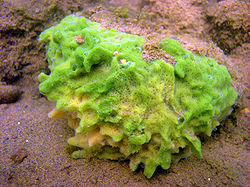
Back Demospongiae Afrikaans إسفنجيات شائعة Arabic اسفنجيات شائعه ARZ Adi süngərlər Azerbaijani عادی سونگرلر AZB Рогови Bulgarian Demosponges Catalan Demospongiae CEB Rohovití Czech Hornkieselschwämme German
| Demosponge | |
|---|---|

| |
| Included are the yellow tube sponge, Aplysina fistularis, the purple vase sponge, Niphates digitalis, the red encrusting sponge, Spiratrella coccinea, and the gray rope sponge, Callyspongia sp. | |
| Scientific classification | |
| Domain: | Eukaryota |
| Kingdom: | Animalia |
| Phylum: | Porifera |
| Class: | Demospongiae Sollas, 1885 |
| Subclasses | |






Demosponges or common sponges are sponges of the class Demospongiae (from Ancient Greek: δῆμος, romanized: dêmos, lit. 'common people' + σπογγιά, spongiá, 'sponge'), the most diverse group in the phylum Porifera which include greater than 90% of all extant sponges with nearly 8,800 species worldwide (according to the World Porifera Database).[5] Being siliceous sponges, they are predominantly leuconoid in structure with an endoskeleton made of a meshwork of spicules consisting of fibers of the protein spongin, the mineral silica, or both. Where spicules of silica are present, they have a different shape from those in the otherwise similar glass sponges.[6] Some species, in particular from the Antarctic, obtain the silica for spicule-building from the ingestion of diatoms.[7]
The many diverse orders in this class include all of the large sponges. About 311 million years ago, in the Late Carboniferous, the order Spongillida split from the marine sponges, and is the only sponges to live in freshwater environments.[8] Some species are brightly colored, with great variety in body shape; the largest species are over 1 m (3.3 ft) across.[6] They reproduce both sexually and asexually. They are the only extant organisms that methylate sterols at the 26-position, a fact used to identify the presence of demosponges before their first known unambiguous fossils.[9][2]
Because of many species' long life span (500–1,000 years) it is thought that analysis of the aragonite skeletons of these sponges could extend data regarding ocean temperature, salinity, and other variables farther into the past than has been previously possible. Their dense skeletons are deposited in an organized chronological manner, in concentric layers or bands. The layered skeletons look similar to reef corals. Therefore, demosponges are also called coralline sponges.
- ^ Botting, J.P.; Cárdenas, P.; Peel, J.S. (January 2015). "A crown-group demosponge from the early Cambrian Sirius Passet Biota, North Greenland". Palaeontology. 58 (1): 35–43. Bibcode:2015Palgy..58...35B. doi:10.1111/pala.12133.
- ^ a b Love, Gordon D.; Grosjean, Emmanuelle; Stalvies, Charlotte; Fike, David A.; Grotzinger, John P.; Bradley, Alexander S.; Kelly, Amy E.; Bhatia, Maya; Meredith, William (2009). "Fossil steroids record the appearance of Demospongiae during the Cryogenian period" (PDF). Nature. 457 (7230): 718–721. Bibcode:2009Natur.457..718L. doi:10.1038/nature07673. PMID 19194449. S2CID 4314662. Archived from the original (PDF) on 2018-07-24. Retrieved 2019-01-27.
- ^ Vacelet, J. (2006). "New carnivorous sponges (Porifera, Poecilosclerida) collected from manned submersibles in the deep Pacific". Zoological Journal of the Linnean Society. 148 (4): 553–584. Figure 17. doi:10.1111/j.1096-3642.2006.00234.x.
- ^ Van Soest, Rob W. M.; Boury-Esnault, Nicole; Vacelet, Jean; Dohrmann, Martin; Erpenbeck, Dirk; De Voogd, Nicole J.; Santodomingo, Nadiezhda; Vanhoorne, Bart; Kelly, Michelle; Hooper, John N. A. (2012). "Global Diversity of Sponges (Porifera)". PLOS ONE. 7 (4): e35105. Bibcode:2012PLoSO...735105V. doi:10.1371/journal.pone.0035105. PMC 3338747. PMID 22558119.
- ^ "World Porifera Database". marinespecies.org. Retrieved 21 October 2015.
- ^ a b Barnes, Robert D. (1982). Invertebrate Zoology. Philadelphia, PA: Holt-Saunders International. pp. 105–6. ISBN 978-0-03-056747-6.
- ^ Riesgo, Ana; Taboada, Sergi; Kenny, Nathan J.; Santodomingo, Nadia; Moles, Juan; Leiva, Carlos; Cox, Eileen; Avila, Conxita; Cardona, Luis; Maldonado, Manuel (2021). "Recycling resources: silica of diatom frustules as a source for spicule building in Antarctic siliceous demosponges". Zoological Journal of the Linnean Society. 192 (2): 259–276. doi:10.1093/zoolinnean/zlaa058.
- ^ Schuster A, Vargas S, Knapp IS, Pomponi SA, Toonen RJ, Erpenbeck D, Wörheide G (July 2018). "Divergence times in demosponges (Porifera): first insights from new mitogenomes and the inclusion of fossils in a birth-death clock model". BMC Evol Biol. 18 (1): 114. Bibcode:2018BMCEE..18..114S. doi:10.1186/s12862-018-1230-1. PMC 6052604. PMID 30021516.
- ^ Brocks, J. J.; Jarrett, A. J. M.; Sirantoine, E.; Kenig, F.; Moczydłowska, M.; Porter, S.; Hope, J. (2016-03-01). "Early sponges and toxic protists: possible sources of cryostane, an age diagnostic biomarker antedating Sturtian Snowball Earth". Geobiology. 14 (2): 129–149. Bibcode:2016Gbio...14..129B. doi:10.1111/gbi.12165. ISSN 1472-4669. PMID 26507690.
© MMXXIII Rich X Search. We shall prevail. All rights reserved. Rich X Search